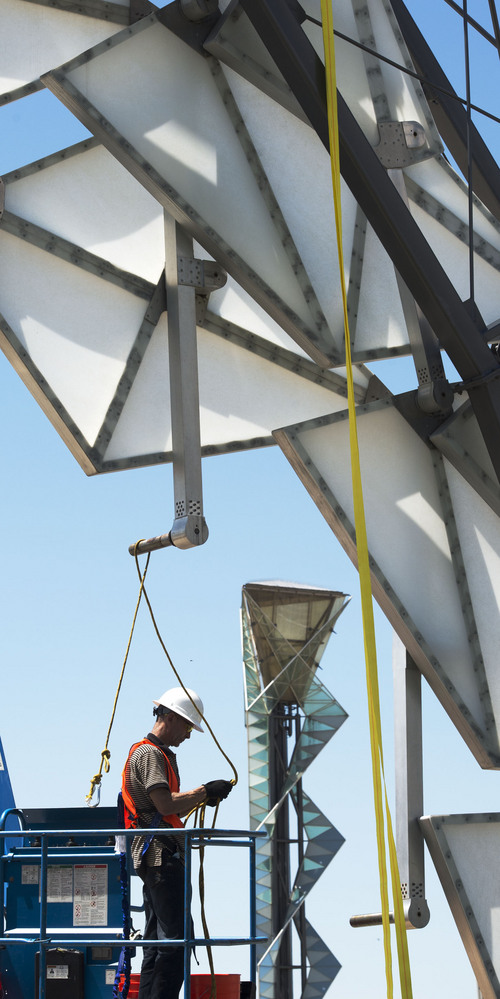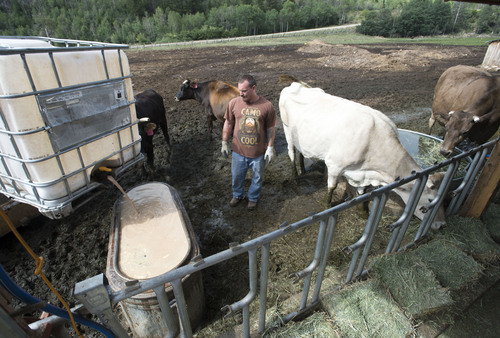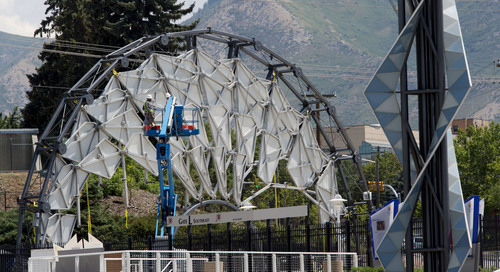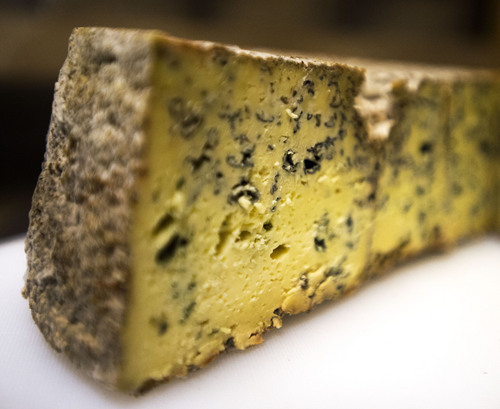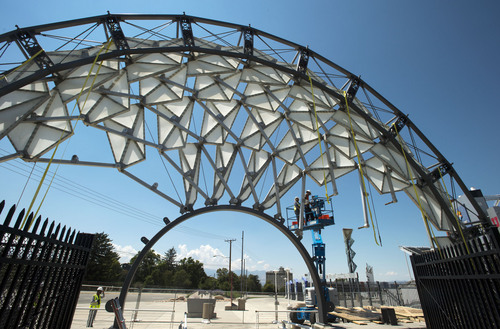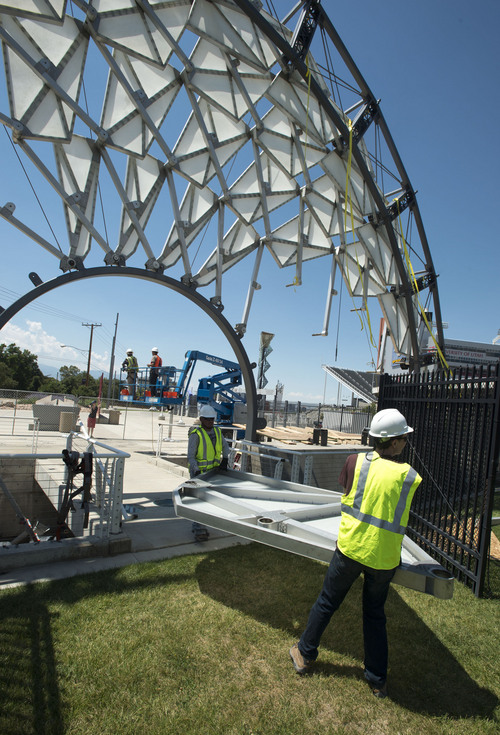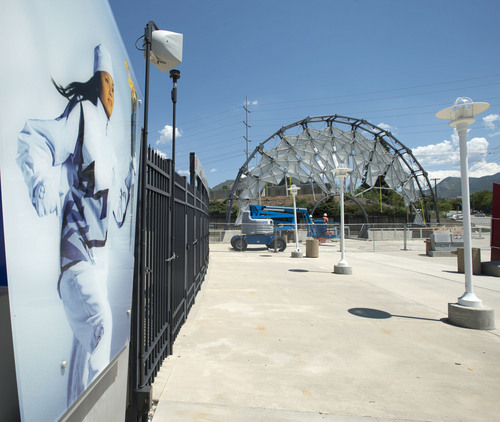Steve Griffin | The Salt Lake Tribune
Cheesemaker Gold Creek Farms near Kamas each week uses barrels and barrels of spent grain
Steve Griffin | The Salt Lake Tribune
Gold Creek Farms ranch manager Ricky Dynes fills a trough with stillage from High West Di
Steve Griffin | The Salt Lake Tribune
A crew from Erichsen Construction Services starts to dismantle the Hoberman Arch from Ri
Steve Griffin | The Salt Lake Tribune
Gold Creek Farms ranch manager Ricky Dynes fills a trough with stillage from High West Di
Steve Griffin | The Salt Lake Tribune
A crew from Erichsen Construction Services starts to dismantle the Hoberman Arch from Ri
Steve Griffin | The Salt Lake Tribune
High West Blue cheese from Gold Creek Farms in Kamas Friday, Aug. 1, 2014.
Steve Griffin | The Salt Lake Tribune
A crew from Erichsen Construction Services starts to dismantle the Hoberman Arch from Ri
Steve Griffin | The Salt Lake Tribune
Gold Creek Farms ranch manager Ricky Dynes fills a trough with stillage from High West Di
Steve Griffin | The Salt Lake Tribune
High West Blue cheese from Gold Creek Farms in Kamas Friday, Aug. 1, 2014.
Steve Griffin | The Salt Lake Tribune
Cheesemaker Gold Creek Farms near Kamas each week uses barrels and barrels of spent grain
Steve Griffin | The Salt Lake Tribune
Cheesemaker Gold Creek Farms near Kamas each week uses barrels and barrels of spent grain
Steve Griffin | The Salt Lake Tribune
A crew from Erichsen Construction Services starts to dismantle the Hoberman Arch from Ri
Steve Griffin | The Salt Lake Tribune
A crew from Erichsen Construction Services starts to dismantle the Hoberman Arch from Ri
Steve Griffin | The Salt Lake Tribune
A crew from Erichsen Construction Services starts to dismantle the Hoberman Arch from Ri
Steve Griffin | The Salt Lake Tribune
A crew from Erichsen Construction Services starts to dismantle the Hoberman Arch from Ri
Steve Griffin | The Salt Lake Tribune
Cheesemaker Gold Creek Farms near Kamas each week uses barrels and barrels of spent grain leftover from the distilling process of High West Distiliiery in Park City to mix in the feed of dairy cows.
Steve Griffin | The Salt Lake Tribune
Gold Creek Farms ranch manager Ricky Dynes fills a trough with stillage from High West Distillery at the farm near Kamas on Friday, Aug. 1, 2014.
Steve Griffin | The Salt Lake Tribune
A crew from Erichsen Construction Services starts to dismantle the Hoberman Arch from Rice-Eccles stadium in Salt Lake City, Utah Friday, August 1, 2014. The university is giving it to Salt Lake City. The city doesn't know yet what it will do with the Olympic Legacy sculpture but, for the time being, will put it in storage.
Steve Griffin | The Salt Lake Tribune
Gold Creek Farms ranch manager Ricky Dynes fills a trough with stillage from High West Distillery at the farm near Kamas on Friday, Aug. 1, 2014.
Steve Griffin | The Salt Lake Tribune
A crew from Erichsen Construction Services starts to dismantle the Hoberman Arch from Rice-Eccles stadium in Salt Lake City, Utah Friday, August 1, 2014. The university is giving it to Salt Lake City. The city doesn't know yet what it will do with the Olympic Legacy sculpture but, for the time being, will put it in storage.
Steve Griffin | The Salt Lake Tribune
High West Blue cheese from Gold Creek Farms in Kamas Friday, Aug. 1, 2014.
Steve Griffin | The Salt Lake Tribune
A crew from Erichsen Construction Services starts to dismantle the Hoberman Arch from Rice-Eccles stadium in Salt Lake City, Utah Friday, August 1, 2014. The university is giving it to Salt Lake City. The city doesn't know yet what it will do with the Olympic Legacy sculpture but, for the time being, will put it in storage.
Steve Griffin | The Salt Lake Tribune
Gold Creek Farms ranch manager Ricky Dynes fills a trough with stillage from High West Distillery at the farm near Kamas on Friday, Aug. 1, 2014.
Steve Griffin | The Salt Lake Tribune
High West Blue cheese from Gold Creek Farms in Kamas Friday, Aug. 1, 2014.
Steve Griffin | The Salt Lake Tribune
Cheesemaker Gold Creek Farms near Kamas each week uses barrels and barrels of spent grain leftover from the distilling process of High West Distiliiery in Park City to mix in the feed of dairy cows.
Steve Griffin | The Salt Lake Tribune
Cheesemaker Gold Creek Farms near Kamas each week uses barrels and barrels of spent grain leftover from the distilling process of High West Distiliiery in Park City to mix in the feed of dairy cows.
Steve Griffin | The Salt Lake Tribune
A crew from Erichsen Construction Services starts to dismantle the Hoberman Arch from Rice-Eccles stadium in Salt Lake City, Utah Friday, August 1, 2014. The university is giving it to Salt Lake City. The city doesn't know yet what it will do with the Olympic Legacy sculpture but, for the time being, will put it in storage.
Steve Griffin | The Salt Lake Tribune
A crew from Erichsen Construction Services starts to dismantle the Hoberman Arch from Rice-Eccles stadium in Salt Lake City, Utah Friday, August 1, 2014. The university is giving it to Salt Lake City. The city doesn't know yet what it will do with the Olympic Legacy sculpture but, for the time being, will put it in storage.
Steve Griffin | The Salt Lake Tribune
A crew from Erichsen Construction Services starts to dismantle the Hoberman Arch from Rice-Eccles stadium in Salt Lake City, Utah Friday, August 1, 2014. The university is giving it to Salt Lake City. The city doesn't know yet what it will do with the Olympic Legacy sculpture but, for the time being, will put it in storage.
Steve Griffin | The Salt Lake Tribune
A crew from Erichsen Construction Services starts to dismantle the Hoberman Arch from Rice-Eccles stadium in Salt Lake City, Utah Friday, August 1, 2014. The university is giving it to Salt Lake City. The city doesn't know yet what it will do with the Olympic Legacy sculpture but, for the time being, will put it in storage.




